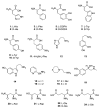Activation Studies of the γ-Carbonic Anhydrases from the Antarctic Marine Bacteria Pseudoalteromonas haloplanktis and Colwellia psychrerythraea with Amino Acids and Amines
- PMID: 31013612
- PMCID: PMC6520686
- DOI: 10.3390/md17040238
Activation Studies of the γ-Carbonic Anhydrases from the Antarctic Marine Bacteria Pseudoalteromonas haloplanktis and Colwellia psychrerythraea with Amino Acids and Amines
Abstract
The γ-carbonic anhydrases (CAs, EC 4.2.1.1) present in the Antarctic marine bacteria Pseudoalteromonas haloplanktis and Colwellia psychrerythraea, herein referred to as PhaCA and CpsCA, respectively, were investigated for their activation with a panel of 24 amino acids and amines. Both bacteria are considered Antarctic models for the investigation of photosynthetic and metabolic pathways in organisms adapted to live in cold seawater. PhaCA was much more sensitive to activation by these compounds compared to the genetically related enzyme CpsCA. The most effective PhaCA activators were d-Phe, l-/d-DOPA, l-Tyr and 2-pyridyl-methylamine, with the activation constant KA values of 0.72-3.27 µM. d-His, l-Trp, d-Tyr, histamine, dopamine, serotonin anddicarboxylic amino acids were also effective activators of PhaCA, with KA values of 6.48-9.85 µM. CpsCA was activated by d-Phe, d-DOPA, l-Trp, l-/d-Tyr, 4-amino-l-Phe, histamine, 2-pyridyl-methylamine and l-/d-Glu with KA values of 11.2-24.4 µM. The most effective CpsCA activator was l-DOPA (KA of 4.79 µM). Given that modulators of CAs from Antarctic bacteria have not been identified and investigated in detail for their metabolic roles to date, this research sheds some light on these poorly understood processes.
Keywords: Antarctic bacteria; Colwellia psychrerythraea; Pseudoalteromonas haloplanktis; activator; amine; amino acid; carbonic anhydrase; metalloenzymes.
Conflict of interest statement
The authors declare no conflict of interest.
Figures
Similar articles
-
The first activation study of the β-carbonic anhydrases from the pathogenic bacteria Brucella suis and Francisella tularensis with amines and amino acids.J Enzyme Inhib Med Chem. 2019 Dec;34(1):1178-1185. doi: 10.1080/14756366.2019.1630617. J Enzyme Inhib Med Chem. 2019. PMID: 31282230 Free PMC article.
-
The first activation studies of the η-carbonic anhydrase from the malaria parasite Plasmodium falciparum with amines and amino acids.Bioorg Chem. 2018 Oct;80:94-98. doi: 10.1016/j.bioorg.2018.06.002. Epub 2018 Jun 4. Bioorg Chem. 2018. PMID: 29894892
-
The first activation study of a δ-carbonic anhydrase: TweCAδ from the diatom Thalassiosira weissflogii is effectively activated by amines and amino acids.J Enzyme Inhib Med Chem. 2018 Dec;33(1):680-685. doi: 10.1080/14756366.2018.1447570. J Enzyme Inhib Med Chem. 2018. PMID: 29536765 Free PMC article.
-
Carbonic anhydrase activators.Future Med Chem. 2018 Mar 1;10(5):561-573. doi: 10.4155/fmc-2017-0223. Epub 2018 Feb 26. Future Med Chem. 2018. PMID: 29478330 Review.
-
The globins of cold-adapted Pseudoalteromonas haloplanktis TAC125: from the structure to the physiological functions.Adv Microb Physiol. 2013;63:329-89. doi: 10.1016/B978-0-12-407693-8.00008-X. Adv Microb Physiol. 2013. PMID: 24054800 Review.
Cited by
-
Comprehensive insights on environmental adaptation strategies in Antarctic bacteria and biotechnological applications of cold adapted molecules.Front Microbiol. 2023 Jun 16;14:1197797. doi: 10.3389/fmicb.2023.1197797. eCollection 2023. Front Microbiol. 2023. PMID: 37396361 Free PMC article. Review.
-
Enzymes from Marine Polar Regions and Their Biotechnological Applications.Mar Drugs. 2019 Sep 23;17(10):544. doi: 10.3390/md17100544. Mar Drugs. 2019. PMID: 31547548 Free PMC article. Review.
-
Amine- and Amino Acid-Based Compounds as Carbonic Anhydrase Activators.Molecules. 2021 Dec 2;26(23):7331. doi: 10.3390/molecules26237331. Molecules. 2021. PMID: 34885917 Free PMC article. Review.
-
The first activation study of the β-carbonic anhydrases from the pathogenic bacteria Brucella suis and Francisella tularensis with amines and amino acids.J Enzyme Inhib Med Chem. 2019 Dec;34(1):1178-1185. doi: 10.1080/14756366.2019.1630617. J Enzyme Inhib Med Chem. 2019. PMID: 31282230 Free PMC article.
-
Activation of the β-carbonic anhydrase from the protozoan pathogen Trichomonas vaginalis with amines and amino acids.J Enzyme Inhib Med Chem. 2021 Dec;36(1):758-763. doi: 10.1080/14756366.2021.1897802. J Enzyme Inhib Med Chem. 2021. PMID: 33715570 Free PMC article.
References
-
- Mocali S., Chiellini C., Fabiani A., Decuzzi S., de Pascale D., Parrilli E., Tutino M.L., Perrin E., Bosi E., Fondi M., et al. Ecology of cold environments: New insights of bacterial metabolic adaptation through an integrated genomic-phenomic approach. Sci. Rep. 2017;7:839. doi: 10.1038/s41598-017-00876-4. - DOI - PMC - PubMed
-
- De Luca V., Vullo D., Del Prete S., Carginale V., Scozzafava A., Osman S.M., AlOthman Z., Supuran C.T., Capasso C. Cloning, characterization and anion inhibition studies of a new γ-carbonic anhydrase from the Antarctic bacterium Pseudoalteromonas haloplanktis. Bioorg. Med. Chem. 2015;23:4405–4409. doi: 10.1016/j.bmc.2015.06.021. - DOI - PubMed
-
- Vullo D., De Luca V., Del Prete S., Carginale V., Scozzafava A., Capasso C., Supuran C.T. Sulfonamide inhibition studies of the γ-carbonic anhydrase from the Antarctic bacterium Pseudoalteromonas haloplanktis. Bioorg. Med. Chem. Lett. 2015;25:3550–3555. doi: 10.1016/j.bmcl.2015.06.079. - DOI - PubMed
MeSH terms
Substances
LinkOut - more resources
Full Text Sources


